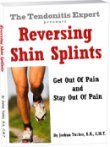Longest Bone In
Human Body
And Attached Problems
The Longest Bone In Human Body is the femur.
Ta da! Easy answer to that question.
Average length 19.6 inches.
That's a lot of real estate. From a tendonitis perspective, there are a lot of muscle attachments and joint structure available on and around the femur that can have problems. This page lists and describes those femur long bone problems.
Longest Bone In Human Body
Connections
The femur runs from from knee to hip. It makes up part of the knee joint and part of the hip joint.
The adductor muscles attach to the femur (on the inside).
The abductor muscles attach to the femur (on the outside [basically]).
The quad muscles attach to the femur (on the front).
The hamstring muscles attach to the femur (on the back...though really only the Biceps Femoris short head and Semimembranosus attaches to the bone itself).
22 muscles attach to the femur. That's a lot of connections to the 'main beam' structure, and being the longest bone in human body, and weight bearing, it creates a lot of opportunity for tendonitis, muscle imbalance, tightness that causes problems, etc.
(Some of) those 22 muscles:
- rotate the femur in both directions.
- cross the knee joint (compress the joint)
- crosses the hip joint (compresses the joint)
- moves the femur in all directions
Some of these muscles work together. Some work against each other. They all put force to some degree upon the femur itself.
Bone In Human Body
Femur Related Problems
Because so many different structures connect to and otherwise interact with the femur, there are a lot of potential problems.
Knee tendonitis
Knee tendonitis can be a problem with one or more of the muscles whose tendons cross the knee joint.
See: Knee Tendonitis
See: Patellar Tendonitis
Knee bursitis
The knee is the bottom of the femur.
Knee bursitis, or patellar bursitis is a scenario where the bursa under the patellar tendon gets irritated by excess force applied by that tendon to the bursa.
Knee bursitis can exist with out any knee tendonitis symptoms, but is caused by the tendonitis dynamic (i.e. chronic tigtness).
See: Patellar Bursitis
Hip Pain
The 'hip' is the top of the femur.
Hip pain can come from a variety of directions. Muscle problem, bone problem, bursa problem, tendonitis problem.
See: Hip Pain
Hip Osteoarthritis
Hip Osteoarthritis is a function of the tendonitis dynamic compressing the hip joint (femur bone and pelvic bone) over time until the interior joint grinding causes irritation and then damage.
See: Hip Osteoarthritis
Osteoporosis
Osteoporosis doesn't affect only the femur, but the neck and head of the femur is a very common place for fractures and full breaks from the weakened state of the femur bone due to the bone density loss that is Osteoporosis.
Pulled Calf Muscle
The gastrocnemius muscles attach to the bottom of the femur. The gastrocs, your calves, can get 'pulled', which really means a small rip or tear.
Most often though, a pulled calf muscle is really more of a pain dynamic from a small cramp and it's repercussions.
See: Pulled Calf Muscle
Hip Tendonitis
Hip Tendonitis is a general term that can apply to issues with one or more of the muscles in the 'butt' area that connect to the top of the femur.
See: Hip Tendonitis
Return to the top of this Longest Bone In Human Body page.
Go to the www.TendonitisExpert.com homepage.
| Share Your Story
|





